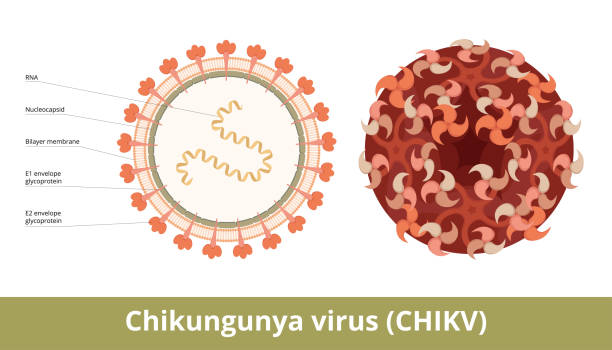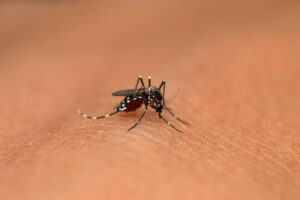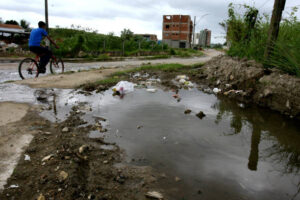Chikungunya
Chikungunya is a viral infection transmitted to humans through the bite of an infected mosquito. The name “chikungunya” comes from a word in the Kimakonde language meaning “that which bends up,” referring to the severe joint pain it causes.
Symptoms:

- Fever
- Severe joint pain, often in the hands, wrists, ankles, and knees
- Muscle pain
- Headache
- Fatigue
- Rash
- Nausea
- Vomiting
Transmission: The virus is spread through the bite of an infected Aedes aegypti or Aedes albopictus mosquito, the same types of mosquitoes that transmit dengue and Zika viruses.

- It cannot be spread directly from person to person.
Treatment:
There is no specific medication to treat chikungunya. Treatment focuses on managing symptoms, such as:
- Rest
- Fluids
- Pain relievers like acetaminophen or ibuprofen
While most people recover from chikungunya within weeks, some may experience joint pain for months or even years.
- Prevention:
- Mosquito Control:
- Use insect repellent
- Wear long sleeves and pants
- Stay in air-conditioned or screened areas
- Eliminate standing water around your home
- Vaccination: A vaccine is available in some regions.
It’s important to note that while the joint pain can be severe, most people recover fully, although in some cases, joint pain may persist for months or even years.
As of late 2023 and early 2024, several countries have been affected by chikungunya outbreaks:
Most Affected Countries:
Countries reporting the highest number of CHIKVD cases are:
- Countries in the Americas: Several countries in South and Central America have reported cases.
- Brazil (391 754)
- Paraguay (2 749)
- Argentina (768)
- Bolivia (409).
- Countries in Asia: CHIKVD cases have been reported in Asia from:
- India (69 439)
- Pakistan (2 447)
- Thailand (468)
- Maldives (389)
- Timor Leste (195)
- Malaysia (72).
Besides India and Pakistan, other Asian countries have also been affected to varying degrees.
It’s important to note that the situation can change rapidly, and new outbreaks may occur in different regions. To get the most accurate and up-to-date information, it’s recommended to consult with local health authorities or travel advisories.
Most countries reporting high CHIKVD burdens are in the Americas, and South and Central America.
WHO and Other Health Organizations’ Advice on Chikungunya
The World Health Organization (WHO) and other health organizations worldwide guide countries affected by chikungunya. Here are some of their key recommendations:
Prevention and Control:
- Vector Control: Implement effective vector control measures, including:
- Larval source reduction: Eliminating breeding sites for mosquitoes.
- Adult mosquito control: Using insecticides to kill adult mosquitoes.
- Personal Protection: Promote personal protective measures like insect repellents, long-sleeved clothing, and mosquito nets.

- Surveillance and Response: Strengthen surveillance systems to detect and respond to outbreaks promptly.
- Clinical Management: Provide appropriate clinical management for patients, including pain relief and supportive care.
Research and Development:
- Vaccine Development: Support research and development of vaccines against chikungunya.
- Diagnostic Tools: Improve diagnostic tools for early detection and accurate diagnosis.
- Therapeutic Interventions: Explore potential therapeutic interventions to alleviate symptoms and reduce disease severity.
International Cooperation:
- Information Sharing: Facilitate the sharing of information and experiences among countries.
- Technical Assistance: Provide technical assistance to countries in need.
- Coordination: Coordinate global efforts to combat chikungunya.
By following these guidelines, countries can effectively prevent and control chikungunya outbreaks, protecting public health and minimizing the impact of the disease.
By following these guidelines, countries can effectively prevent and control chikungunya outbreaks, protecting public health and minimizing the impact of the disease.
Sources and related content
Transmission of Chikungunya Virus – CDC ,
www.cdc.gov
Symptoms, Diagnosis, & Treatment | Chikungunya Virus – CDC
www.cdc.gov
There isn’t a widely recognized alternative name for chikungunya. However, it’s worth noting that in the past, certain diseases were mistakenly labelled as chikungunya due to similar symptoms. For example, in the 18th century, dengue fever was sometimes referred to as chikungunya.
The name “chikungunya” itself comes from the Kimakonde language of Tanzania and means “that which bends up.” This refers to the severe joint pain and contorted posture that often accompanies the disease.
chikungunya is often seasonal
Its transmission is heavily influenced by the activity of the Aedes mosquitoes, which thrive in warm, humid conditions. Therefore, outbreaks typically occur during the rainy seasons in tropical and subtropical regions.
However, it’s important to note that with climate change, the geographic range and seasonal patterns of mosquito-borne diseases, including chikungunya, may be shifting. So, while it’s traditionally a seasonal disease, its occurrence can vary depending on local climatic conditions and the presence of the Aedes mosquito.
Unfortunately, there’s no specific medication to treat chikungunya.
Treatment primarily focuses on managing symptoms, which often include:
- Rest: Getting plenty of rest can help the body recover.
- Fluids: Staying hydrated is crucial to alleviate fever and joint pain.
- Pain Relievers: Over-the-counter pain relievers like acetaminophen (paracetamol) can help reduce fever and ease pain. However, avoid aspirin or other non-steroidal anti-inflammatory drugs (NSAIDs) like ibuprofen until dengue fever is ruled out, as these medications can increase the risk of bleeding in some cases.
It’s essential to consult a healthcare provider for proper diagnosis and treatment, especially if symptoms are severe. They can provide specific advice and recommend appropriate medications based on your situation.
The primary risk factor for chikungunya is exposure to the bite of an infected Aedes mosquito. This risk is heightened in areas where these mosquitoes are prevalent, particularly during their peak activity periods.
Factors that can increase your risk:
- Travel to affected areas: If you’re travelling to regions with ongoing outbreaks, your risk of exposure is higher.
- Living in endemic areas: People residing in areas where chikungunya is endemic are more likely to be exposed.
- Lack of preventive measures: Not taking preventive measures like using insect repellent, wearing protective clothing, and avoiding mosquito-prone areas can increase your risk.
Risk Factor
- Older adults
- Individuals with underlying health conditions(such as diabetes, hypertension, or heart disease)
- Pregnant women(as the virus can be transmitted to the fetus)
By understanding these risk factors, you can take appropriate precautions to protect yourself from chikungunya.
Preventive Measures for Chikungunya
Many preventive measures for dengue are also effective against chikungunya, as both diseases are transmitted by the same type of mosquito.
Key preventive measures:
Personal Protection:
- Use Insect Repellent: Apply EPA-registered insect repellents containing DEET, picaridin, IR3535, or oil of lemon eucalyptus to exposed skin and clothing.
- Wear Protective Clothing: Cover as much skin as possible with long-sleeved shirts, long pants, and socks.
- Use Mosquito Nets: Sleep under mosquito nets, especially during peak mosquito hours.
- Avoid Peak Mosquito Times: Limit outdoor activities during dawn and dusk when mosquitoes are most active.
Environmental Measures:

- Eliminate Standing Water: Regularly empty containers that can hold water, such as flowerpots, buckets, and birdbaths.
- Cover Water Storage Containers: Keep water storage containers tightly covered.
- Use Larvicides: Treat water storage containers with larvicides to kill mosquito larvae.
While many preventive measures overlap, it’s crucial to stay updated on specific recommendations for your region, as local health authorities may have additional advice based on current outbreaks and conditions.
For the most accurate and up-to-date information, consult with local health officials or healthcare providers.
While herbs and spices can offer some relief from symptoms and boost immunity, they cannot directly prevent chikungunya. The primary prevention strategy is to avoid mosquito bites.
However, here are some herbs and spices that can be beneficial during a chikungunya infection:
- Turmeric: Known for its anti-inflammatory properties, turmeric can help reduce joint pain and swelling.
- Ginger: Ginger can soothe digestive issues and reduce nausea, a common symptom of chikungunya.
- Garlic: Garlic has antiviral properties and can boost immunity.
- Tulsi (Holy Basil): This herb is known for its immune-boosting and anti-inflammatory properties.
- Lemon: Rich in vitamin C, lemon can help boost immunity and aid in recovery.
Remember, these herbs and spices can be used as complementary therapies alongside medical advice. Always consult with a healthcare professional for proper diagnosis and treatment.
If you enjoyed this article, please like and share it with your friends. Don’t forget to Share your personal experience/observations thoughts and valuable suggestions for the education /benefit of others. Do subscribe to remain onboard and get more great content!
https://mrpo.pk/?p=6589&preview=true



